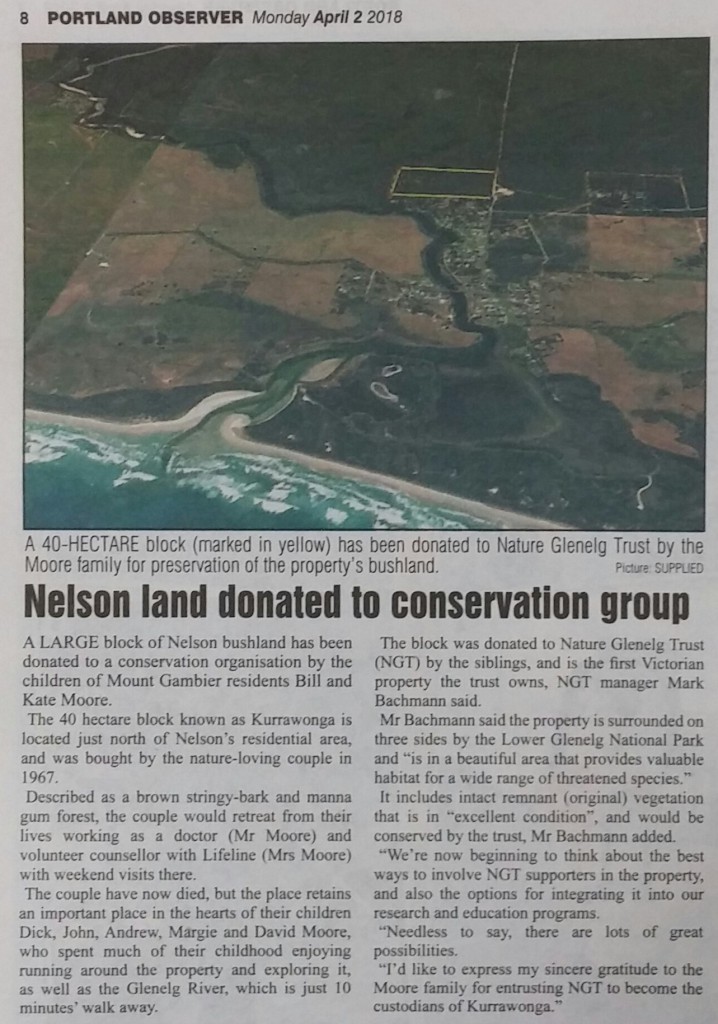The donation of Kurrawonga generates a lot of interest!
Last month’s announcement of the incredibly generous donation of Kurrawonga at Nelson by the Moore family has generated some wonderful positive feedback. Thanks to those of you that shared your happy memories of times spent over the years on the property with Bill and Kate Moore, and for your best wishes to NGT as the new custodian of this beautiful patch of bushland.
Some of the most detailed feedback came from Mt Gambier’s Geoff Aslin, whose connection to Kurrawonga even pre-dates the Moore’s purchase in 1967. I’ll let Geoff explain that connection in his own words:
“Wonderful news to learn of the Moore family’s donation of native bushland at Nelson. I spent a lot of my time during teenage years with my parents staying with the previous owners during the late 1950s and early 1960s.
The first owner was a doctor from Ballarat who built a house near Simsons Landing on the Glenelg River in 1888. The house is still there to this day. I do not know how long that person was there. My parents were close friends with the O’Donohues who later owned the house and land. They lived there from the 1940s to the late 1960s.
Mr. O’Donohue was and early conservationist, naturalist and had great knowledge of the flora and fauna on the property and the surrounding scrubland. “Pop” O’Donohue, as he was known to most people who knew him, was the first ranger in the Nelson area.
I feel the work that “Pop” carried out in the Nelson district in those early years has been forgotten as time has gone by. He spoke of Crosbie Morrison (I liken him to a modern day David Attenborough) who visited and stayed with him in the early years. Morrison was naturalist who was widely known to me in my primary school years of the late 1940s and 1950s. He was a newspaper columnist but I specially remember his nature magazine called “Australian Wildlife”. He was also a lecturer and radio broadcaster. Once a week in primary school we had a nature study lesson in the mornings and listened to Crosbie Morrison on the wireless speaker system.
Back to the O’Donohues. Unfortunately my recollections are a bit vague now of Pop O’Donohue. I referred to them as Mr and Mrs O’Donohue and can’t remember their first names. When I was about 12 years old in the late 1950s Pop and my father would drive me down to the mouth of the Glenelg River. With a bottle of water and a sandwich I would walk along the beach as far as Noble Rocks in Discovery Bay. On the return journey I would explore the Major Mitchell Hummocks where I would look at Aboriginal middens, Long Swamp and the vegetation and wildlife.
We always spent some time with the O’Donohues walking through their scrub land. I remember once in the now National Park, Pop showed us and old post and rail fence where an old pioneer was found deceased and was buried at that spot. He mentioned other graves in the area from 1800s. It is hoped they are documented somewhere.
He had a special patch of Calectasia cyanea (Blue Tinsel Lily) growing near their property. We would admire them when they were in flower along with the heaths and orchids. A few slides taken back then with the O’Donohues still survive.
Pop would take us down to Lake Bung Bung, as it was known by most people back then. He had a wealth of information on the area.
I am a member of the South East Field Naturalist Society from its formation in 1963. At one meeting (late 1960s) Bill Moore mentioned to me that he and Kate had bought some scrub land at Nelson. I remarked that my parents had close friends down there with the name of O’Donohue. To my surprise Bill replied, “That is who we bought the block from”.
Many excursions were had with Bill and Kate at Kurrawonga by various Field Naturalist groups, especially members from Millicent. A Sighting Book was passed around at each monthly meeting and Bill and Kate always had something interesting to report. It could be a new species of orchid or bird that they had seen at their block.
Peter Penney and myself had a special interest in orchids. Many times we received a phone call from Bill letting us know that a particular species of spider and other orchids were in flower. The invitation was always there for us to go and photograph them there.“
If anyone else has stories to share about Kurrawonga, please follow Geoff’s lead – by writing them down and getting in touch. It will most helpful for when we begin to document the history of the site.
Finally, the story of the donation of Kurrawonga also prompted the following ABC South East Radio interview, and an article in the Portland Observer which are provided here for you to listen to or look at, in case you missed them!

